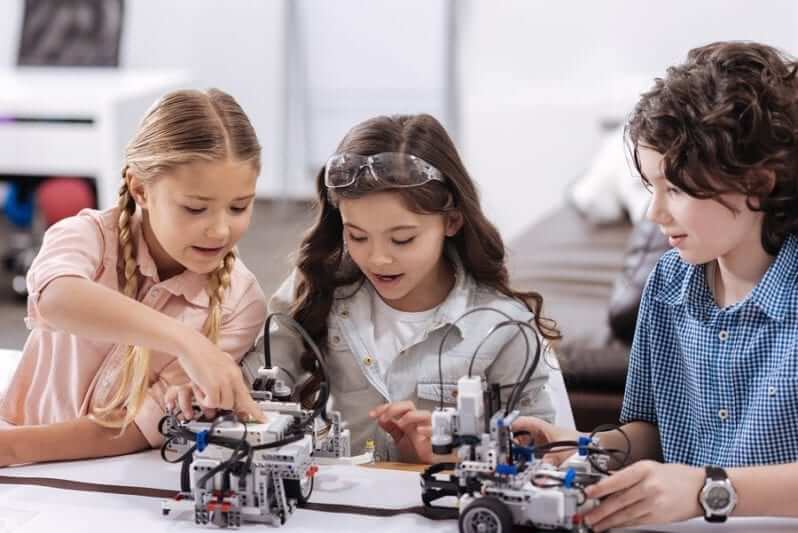I challenged myself this year to change the way I assessed my kids. I finally did it: I threw out my formal paper and pen tests, and started using wrap up lab assessments. Gone are the days where my students would sigh and clear their desks for the test; now they take their resources out and put their brains together for the comprehensive challenge of an application lab.
I now use engineering as my assessment piece, and I want to encourage you to try it as well. Why? Well, it is ALL OVER the NGSS standards, and, as science teachers, we have to incorporate this into our lessons. Regardless, if you design with your curriculum in mind, engineering allows students to problem solve using concepts and skills from the unit in the ultimate form of an application assessment. As a teacher, I LOVE this. And I am not the only one: the students love it, too!
Why do kids love engineering? So many reasons. For one, they are not alone. They are putting their heads and ideas together and engaging their communication skills, learning how to lead, learning how to share ideas, listen, and compromise (some of those NGSS 21st century skills.) That’s right, they get to talk- which really make my middle school students happy, but really, this keeps children of all ages happy. There is less pressure on them since they can always look back and discuss with their group. Kids can be who they are, using their strengths to help the group, and leaning on others in their weaknesses.
Students also find it freeing that there is not one right answer. Each group can come up with an individual plan and prototype, since they are not being told what to do, and the possibilities are limitless.
But here’s the real game changer: it’s OK to fail! Sometimes their plans don’t work! But in the world of engineering, this is not the end. We talk about it, we learn from it, we try again. In failing, they learn, and find success.
How do we engineer? I introduce the steps in September as part of my beginning of the year training, and I find that kids need some time adjusting to this new approach to assessment.
Step 1 – The Task:
I introduce the engineering task right up front- at the beginning of the unit, so the students know where they are going. This will cause them to think about the problem from the start. They will look for pieces of the puzzle as they move through the unit, consider their area of expertise in the task at hand, and gather information accordingly. It gives them a goal, a pathway. But more than that, use it as the hook, the motivating piece that gets their buy in from day one.
From there, I break the unit into small lessons, beginning all of them with experiences that they can draw from to figure out the concepts with a few nudges and cues from me. I end lessons with some sort of a formal piece of the information kids have figured out (could be written notes, a foldable, journal entry, a lab sheet.) Together, these are the pieces that will make the unit and the clues for them to solve the engineering problem.
After all the pieces are in place, we come to assessment day. Instead of everything going away, kids can keep all of their notes, labs, foldables, and textbook out. Instead of silence, groups are encouraged to put their heads together in Step 2.
Step 2 – Brainstorm:
To ensure that all students’ ideas are heard and shared, I have students take a few minutes (or maybe as a homework assignment) and silently and independently design in a sketch. These sketches are then shared within their groups, and students compromise to complete Step 3.
Step 3 – Design:
This step should include a blueprint or sketch. With this shared plan in hand, every student can move on to Step 4.
Step 4 – Build:
Unlike a paper and pen assessment where students hand it in and wait to see if it’s right, in engineering, students are encouraged to test out their design often (step 5-Test) during the building time.
Step 5 – Test:
This is pretty self-explanatory.
Step 6 – Redesign:
The final prototype (working model) is probably not where the group started, it is where they worked to through Step 6. As tests reveal errors, student groups troubleshoot to solve the problems, building iterations (new versions of the prototype) for the best possible final prototype.
Step 7 – Communicate:
Have the kids share these final solutions with the class in Step 7 – Communicate. Do this through a demonstration showcase that cultivates their public speaking skills. During the presentations, have the students assess each project on paper. These can be used later to plan and design the ultimate prototype in the reflection- having learned from everyone’s successes and failures. The final reflection piece is essential. This happens after the engineering class, and independently. This is where the students explain the pieces of the unit that got them to their solution, and where I weigh most of my grade. After all, sometimes the science is spot on, even if it didn’t work out as planned.
If you want a better picture of what your students are understanding, and a better way to discover if they can actually apply the concepts and demonstrate higher levels of learning, it’s time to drop that multiple choice test, and try some engineering!
Know of any good group problem solving techniques let us know in the comments!
-Jessica Cicalese-Kurtz
Jessica Cicalese Kurtz is a middle school Science teacher and curriculum writer at Toms River Schools. She has a bachelor’s degree in Biology, a masters degree in k-12 Education and Technology, and most recently participated in the teacher leaders PISA2 engineering program at Stevens Institute. Her science and education background ranges from veterinary care, wildlife and naturalist education outreach, safari exotic animal care, and aviation instruction. She is married with 4 beautiful children between the ages of 4 and 12. She enjoys spending time with her family, traveling, outside exploring and adventures, taking care of animals, and writing.





